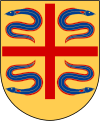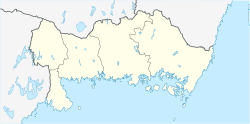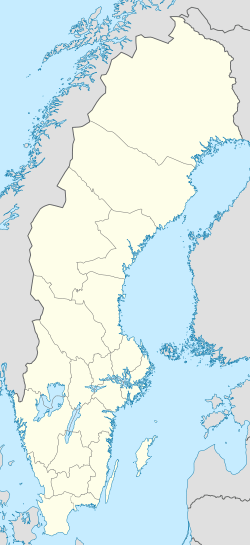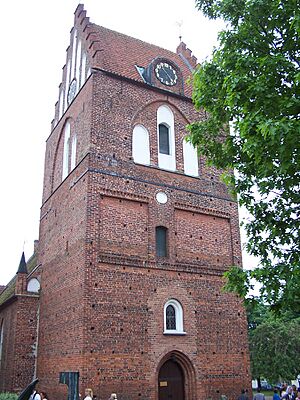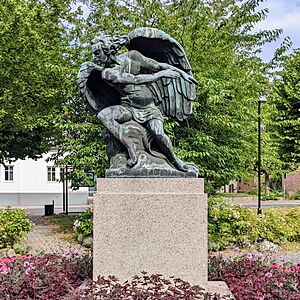Sölvesborg facts for kids
Quick facts for kids
Sölvesborg
|
||
|---|---|---|
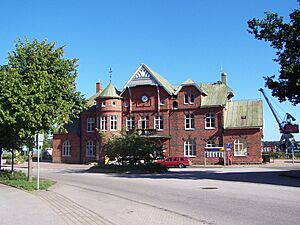
Sölvesborg railway station
|
||
|
||
| Country | Sweden | |
| Province | Blekinge | |
| County | Blekinge County | |
| Municipality | Sölvesborg Municipality | |
| Charter | 1445 | |
| Area | ||
| • Total | 6.10 km2 (2.36 sq mi) | |
| Population
(31 December 2010)
|
||
| • Total | 8,401 | |
| • Density | 1,378/km2 (3,570/sq mi) | |
| Time zone | UTC+1 (CET) | |
| • Summer (DST) | UTC+2 (CEST) | |
Sölvesborg is a town in Blekinge County, Sweden. It is the main town of Sölvesborg Municipality. In 2013, about 10,024 people lived there.
Even though Sölvesborg has a smaller population today, it is still called a city because of its long history. However, Statistics Sweden only counts places with more than 10,000 people as cities.
Contents
Exploring Sölvesborg's Past
The area around Sölvesborg became open for people to settle after the big Baltic Ice Lake water went away. The first people to live here were farmers. We know this because tools and other things from the Stone Age have been found. These old items were mostly found near places like Gammalstorp and Siretorp.
The large hill to the east, called Ryssberget, was formed by moving glaciers. You can see how the ice moved at different times on its western side. An old lake, Vesan, which is now drained, was also created by the ice age.
How Sölvesborg Began
The port town of Sölvesborg started in the 12th century. It grew up around its church, a monastery, and later, a castle. The oldest part of the Saint Nicholas church is from the 12th century. In the 14th century, the church was part of a Carmelite convent.
Around the same time the church was built, a castle also began to take shape. At first, it was probably just a strong fort. Over the years, the castle was made taller and covered a larger area.
Sölvesborg officially became a city in 1445. This was decided by Christopher of Bavaria, who was the king of the Kalmar Union (which included Sweden, Denmark, and Norway).
A City of Importance
Sölvesborg was very important because it was on the main road between the Danish areas of Skåne and Blekinge. A strong fortress was built here because Sölvesborg was the main city in its own region, called Sölvesborgs län.
The name Sölvesborg might come from the castle's founder, Sölfwitz. So, it would mean "Sölfwitz's castle." Others think it might be named after a Norse Viking King named Sölve.
During the Middle Ages, Sölvesborg was a key city in the west. It was often visited by Danish rulers.
Changes and Challenges
Later, the Danish king Christian IV wanted to build a new city called Christianstad. To do this, he took away the trading rights from Sölvesborg. This made Sölvesborg less important, and it started to decline.
The castle was left empty after Denmark lost a battle to Sweden in 1637. Instead of letting the Swedes take the castle, its leader decided to burn it down. Today, only ruins remain.
Sölvesborg did not get its city rights back until 1841. This was done by the Swedish king Carl XIV.
What Sölvesborg Makes and Does
In the 18th century, a porcelain factory started in Sölvesborg in 1773. It made a type of porcelain called faience. This factory only lasted for a few decades and closed in 1790.
Later, in 1901, a glass factory opened. To get sand for the glass, a train line was built to Olofström and Älmhult. The glass factory closed in 1982. A shipping dock also operated in the city from 1892 until 1982.
Today, most of the old factories are gone. Sölvesborg now relies on people who travel to work in other towns. It also has small businesses and a growing tourism industry.
Outside the city, fishing is important, especially in the harbor towns of Djupekås, Hällevik, and Nogersund. In Norje, there is a large chicken farm. Nearby paper mills in Mörrum and Nymölla also provide jobs.
Getting Around Sölvesborg
Sölvesborg got its first railroad connections in the late 1800s. These connected it to Karlshamn and Kristianstad. Later, the line was extended to Karlskrona in the east. Today, this is the only train line left. It connects Karlskrona in the east with Malmö and Copenhagen in the west.
In 1910, more train lines were built to the countryside around Sölvesborg. One line went to Mjällby and ended in Hörvik. This line ran until the 1950s.
Another train line was built between Sölvesborg and Älmhult, the city where IKEA started. This route had the first and longest natural railway tunnel in Scania. Today, only part of this line is used for industrial trains.
The main road connection is the E22 highway. From 1993 to 1999, you could even take a hovercraft from Sölvesborg to Wolgast in Germany during the summer.
Sölvesborg still has its charming old street layout. Even after a big fire in 1801 that burned down almost the whole city, people decided to keep the old street plan instead of building new, straight streets.
Places to See in Sölvesborg
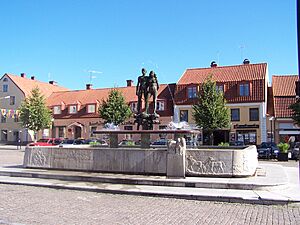
Besides the Ryssberget hill, the small villages outside Sölvesborg are very pretty. In July, the village of Krokås celebrates Ålafiskets dag, which is a day for eel fishing.
In central Sölvesborg, you can visit the twin hills of Kanehall and Vitehall. These used to be great lookout points. They are located in a large beech tree forest, which is one of Europe's biggest. Today, the trees have grown tall, so you need to go higher up Ryssberget for the best views.
Before reaching Kanehall and Vitehall, you will pass the houses on Norregatan. These houses show what the old town looked like. This area was once called Fattigstaden, or "The Poor people's town." The town center itself is a good example of how towns were planned in the Middle Ages in Sweden and Denmark.
Other interesting places to visit include the Nicolai Church. Its oldest parts are from the 12th century. You can also see runestones inside and outside the church. The best-preserved runestone is inside.
The Museum and Gallery are located in old warehouses by the harbor. The museum tells the story of the city, from its first settlers to the early 1900s. The gallery shows art by local artists.
In 1985, SR International - Radio Sweden built a powerful radio station in Sölvesborg. Its two tall antenna towers, about 10 kilometers from the town, are easy to spot. They broadcast international programs to a large part of Europe.
During the summer, visiting one of the many beaches is a great idea. Popular beaches include Sandviken, Tredenborg, and Hällevik.
Sports Teams in Sölvesborg
Sölvesborg has several sports clubs:
- Mjällby AIF
- Hörvikens IF
- Sölvesborgs GoIF
- Lörby IF


